Lamb necks are one of the cheapest cuts of meat available. If you re
after some hearty comfort food and only have loose change in your pocket
then lamb necks are a good way to serve four people for less than the
price of one Big Mac. Lamb shanks used to be a
good standby but the prices have gone up to anywhere between $4 and $6
at the markets and as for the supermarkets - but only the uber rich shop
for meat at the supermarkets. Lamb necks are still (May 2013) only $1 or
$2 each at the
South
Melbourne Market (see below) for large meaty ones. Needless to say,
if they are large they won’t be ‘lamb’ but hogget or mutton, but that s
better because they have more flavour and long slow cooking will get rid
of any toughness.
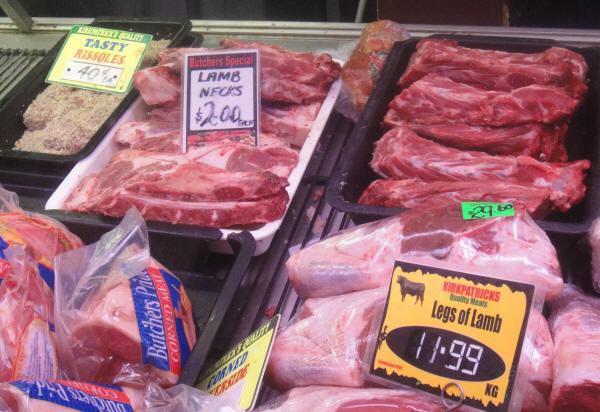
Here are two ways we like to cook them.
Hearty lamb neck casserole
Have your butcher trim off any excess fat, cut them
up and trim the tendons. If it’s peak hour at the market having them cut is all
a cheapskate customer like you can expect when you are holding up the lady
wanting to buy a piece of eye fillet, but that s fine - you can do the rest
yourself and your meat will end up tastier than hers.
.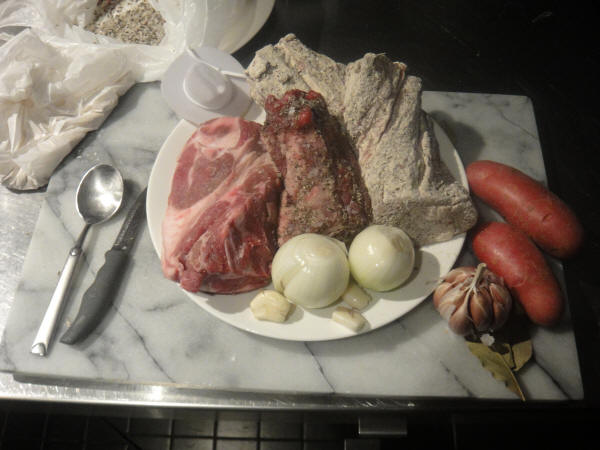
In a plastic bag (I know, I know, you never use them, but try doing this in
your fancy green cloth bag) place some plain flour, paprika and ground pepper and
shake your next pieces one at a time in this mixture to coat them. Brown them in
a heavy bottomed casserole dish and remove them.
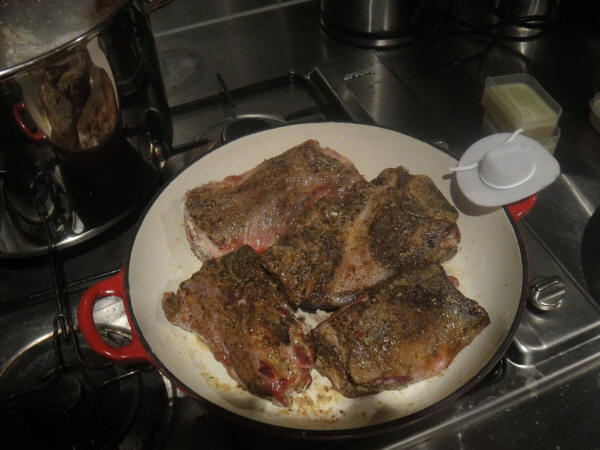
Deglaze the pan with some white wine. It is a little known fact that the wine
that has been sitting at the top of the bottle is chemically unsuited to
deglazing so it is necessary to drink that portion at this stage. When the pan
is nearly dry again add olive oil, chopped onions and garlic. Traditionally
carrots and celery would also be added but anyone who grew up on a diet of
Women s Weekly casseroles will probably choose to forego the sweetness of carrot
and head for some of the more bitter vegetables such as fennel and squash or
whatever s in the crisper draw. It doesn’t matter if the vegetables are a bit limp - they will be
unrecognisable after three hours cooking. Chilli is good too, but just enough to
add depth of flavour rather than substantial heat. It’s a useful chance to use
those anaemic banana peppers that don’t have enough sweetness to call themselves
a capsicum but on the other hand not enough testosterone to call themselves a
chilli. Herbs are also good at this stage but don t bother with any of your
namby-pamby designer hydroponic vaguely green creations that are long on shelf
life but short on flavour. Better to use something hearty like rosemary or bay leaves
and bruised juniper berries.
Once the vegetables have softened it’s time to add tomatoes. Fresh tomatoes
would be good but that would double the price of the dish and wouldn’t be
particularly noticeable at the end, so save them for salad. Canned tomatoes are
fine. We prefer to use whole peeled tomatoes with the often-inferior juice in
which they are packed drained away. Break up the tomatoes, add some chicken
stock and a little more wine, remembering that the top part is unsuitable for
cooking but fine for drinking.
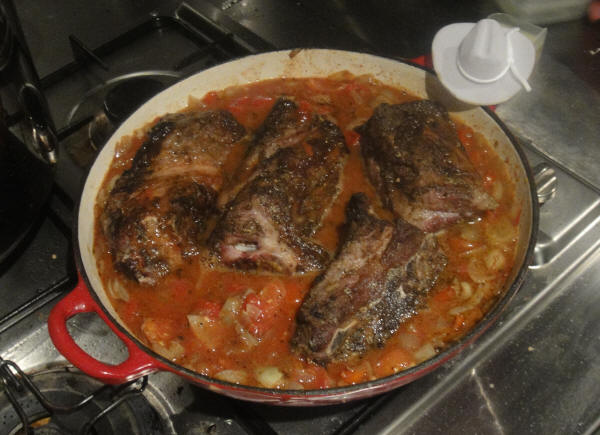
Bring the mixture up to the simmer then return the meat, cover with baking
paper to keep the steam in, place the lid on the casserole dish and cook in a
medium oven for several hours, turning the meat from time to time.
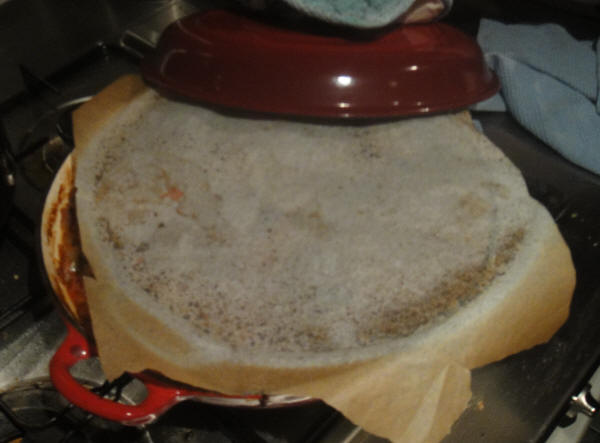
At this stage the cooking sauce is ready to be removed, cooled and stored
overnight. ‘Twice cooked’ is the term you will see in restaurants rather than
‘cooled to remove the fat then reheated’. After several hours we remove the meat
and pour the sauce into a thinnish tall container (tall and thin makes it easier
remove the fat rather than short and fat) suited to the door of the fridge so
that excess fat can be removed the next day. In theory meat and sauce are stored
at least overnight but we have to admit that our lamb necks rarely make it to
the fridge without a substantial chunk being devoured.
The next day, or whenever you are ready to reheat, return the meat and sauce
to the casserole dish. At this stage we like to add some olives or capers to
further darken the flavour of the sauce. The aim is to have a thick syrupy sauce
rather than the thin soupy boarding-school-variety. If it gets too thick you can
always add some more wine - in fact it s good to keep the bottle nearby just in
case. We also like to add quartered lemon which always goes well with lamb.
Hearty greens are needed for some contrast. Flat leaf parsley is good but
chopped celery leaves are even better.
Mashed spuds are the obvious companion and some sweet vegetables on the side
to contrast with the deep flavours of the meat and the sauce - failing that, some
sweet chutney works well. Two large necks at $2 each will feed four people and
the flavour of the meat is much richer than your poncy leg of lamb so you don’t
need as much. Relatives and visitors can sometimes get squeamish about the
concept of lamb necks so for that reason I suggest you call it Mouton Cuit
Deux Fois.
___________________
 ___________________
___________________
Lamb neck with spring vegetables in broth
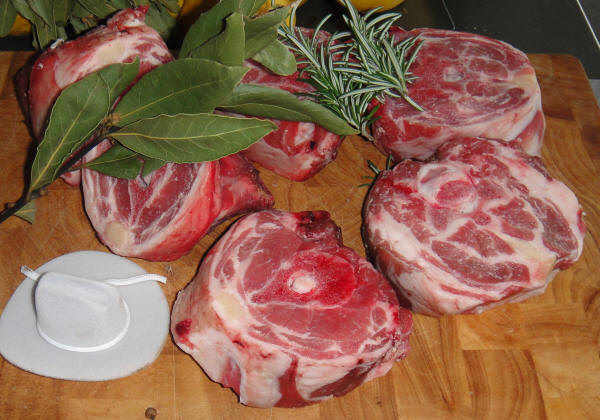
In the warmer months lamb necks can make a lighter more delicate meal. For
this recipe you need the type of lamb necks that are cut into thick discs.
Soften some onion and garlic in olive oil in a heavy bottomed pan on the stove.
Ideally you want a pan or dish large enough to fit your 3 or 4 neck discs in one
layer. Add the necks and brown on both sides. Season with salt and freshly
ground pepper (but no flour in this case because we are looking for a fairly
clear broth). When suitably browned add just enough cold water to cover the
meat. You don’t need stock in this case because the meat and the bones are going
to create their own. Add carrots and celery cut into bite sized pieces along
with a couple of bay leaves and some lemon thyme (or whatever suitable herbs you
have in your garden or window box.
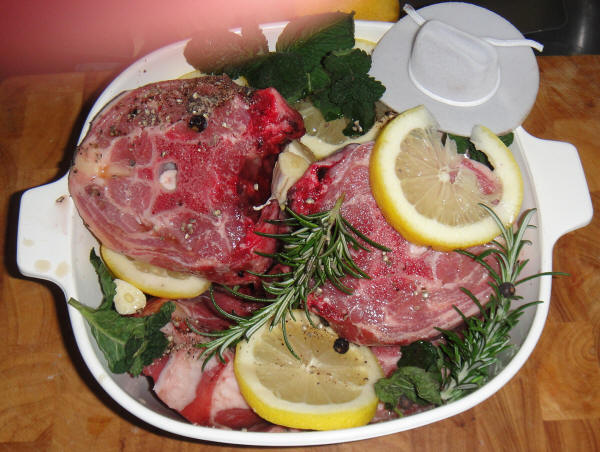
Bring the water to the simmer, then cover and simmer slowly for several
hours. During those several hours you could vacuum or do the washing, but our
research has shown that the vibrations produced by such activity in the house
interferes with the delicate balance of the newly forming broth so it is safest
to put your feet up, pour a glass of whatever you fancy, and read a book. You
owe it to your valued family or friends not to spoil the quality of their meal.
After several hours, remove the lid and add some fresh spring greens. If you
don’t have any handy, frozen peas and/or beans are fine. You might also want to
add some canned pulses such as broad beans or cannellini beans which have been
drained and rinsed well - we suggest not too many. Finally a garnish of freshly
chopped delicate herbs such as parsley, basil, chives, mint or whatever you have
to hand. For serving, extract one neck piece and some assorted vegetables per
serve.
The broth presents three options.
- The meat and veg can be served on a low flat plate in some broth with
some toasted crusty bread on the side to soak up any excess liquid
- The broth can be served on the side in small bowls
- The broth can be omitted and discarded - HANG ON A MINUTE - that’s first
rate lamb broth - put in the fridge overnight, remove any excess fat and use
it as meat stock in your future cooking
During the cooking you will notice that the fat that was originally on the
necks has considerably reduced in size. That’s because the wonderful Slimming
Fairy has visited and spirited it away to a place where it won’t have any effect
on your overall weight or shape and all thats left behind is a lovely
glistening sheen on the broth as a reminder of her magical deeds - at least
that s what we at White Hat believe. Lamb in broth doesn’t really need much in
the way of accompaniments. Maybe some mild mustard or even mint sauce but
nothing too overpowering - except in the case of Uncle George who you know is
going to smother it in salt before he even tastes it. Sometimes you get no
thanks for going to the effort of keeping vibrations down in the house while it
was cooking.
|
|
Copyright © 1995 - 2025
White Hat.
|
___________________
 ___________________
___________________
If you found this recipe useful then subscribe to
our
free food newsletter for more recipes in
this style.
Related pages